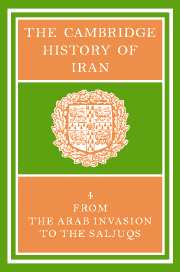Book contents
- Frontmatter
- 1 THE ARAB CONQUEST OF IRAN AND ITS AFTERMATH
- 2 THE ‘ABBĀSID CALIPHATE IN IRAN
- 3 THE ṬĀHIRIDS AND ṢAFFĀRIDS
- 4 The SĀMĀNIDS
- 5 THE EARLY GHAZNAVIDS
- 6 THE MINOR DYNASTIES OF NORTHERN IRAN
- 7 IRAN UNDER THE BŪYIDS
- 8 TRIBES, CITIES AND SOCIAL ORGANIZATION
- 9 THE VISUAL ARTS
- 10 NUMISMATICS
- 11 THE EXACT SCIENCES
- 12 LIFE SCIENCES, ALCHEMY AND MEDICINE
- 13(a) PHILOSOPHY AND COSMOLOGY
- (b) SŪFISM
- 14 THE RELIGIOUS SCIENCES
- 15 SECTS AND HERESIES
- 16 NĀSIR-I KHUSRAU AND IRANIAN ISMĀ‘ĪLĪSM
- 17 ZOROASTRIAN LITERATURE AFTER THE MUSLIM CONQUEST
- 18 ARABIC LITERATURE IN IRAN
- 19 THE RISE OF THE NEW PERSIAN LANGUAGE
- 20 (a) THE “RUBĀ'Ī” IN EARLY PERSIAN LITERATURE
- (b) ‘UMAR KHAYYĀM: ASTRONOMER, MATHEMATICIAN AND POET
- Bibliography
- Index
- Plate section
- Plate section">
- Map 1. Iran under the Abbasids">
- References
(b) - ‘UMAR KHAYYĀM: ASTRONOMER, MATHEMATICIAN AND POET
Published online by Cambridge University Press: 28 March 2008
- Frontmatter
- 1 THE ARAB CONQUEST OF IRAN AND ITS AFTERMATH
- 2 THE ‘ABBĀSID CALIPHATE IN IRAN
- 3 THE ṬĀHIRIDS AND ṢAFFĀRIDS
- 4 The SĀMĀNIDS
- 5 THE EARLY GHAZNAVIDS
- 6 THE MINOR DYNASTIES OF NORTHERN IRAN
- 7 IRAN UNDER THE BŪYIDS
- 8 TRIBES, CITIES AND SOCIAL ORGANIZATION
- 9 THE VISUAL ARTS
- 10 NUMISMATICS
- 11 THE EXACT SCIENCES
- 12 LIFE SCIENCES, ALCHEMY AND MEDICINE
- 13(a) PHILOSOPHY AND COSMOLOGY
- (b) SŪFISM
- 14 THE RELIGIOUS SCIENCES
- 15 SECTS AND HERESIES
- 16 NĀSIR-I KHUSRAU AND IRANIAN ISMĀ‘ĪLĪSM
- 17 ZOROASTRIAN LITERATURE AFTER THE MUSLIM CONQUEST
- 18 ARABIC LITERATURE IN IRAN
- 19 THE RISE OF THE NEW PERSIAN LANGUAGE
- 20 (a) THE “RUBĀ'Ī” IN EARLY PERSIAN LITERATURE
- (b) ‘UMAR KHAYYĀM: ASTRONOMER, MATHEMATICIAN AND POET
- Bibliography
- Index
- Plate section
- Plate section">
- Map 1. Iran under the Abbasids">
- References
Summary
Ghiyāth al-Dīn Abu'1-Fath ‘Umar b. Ibrāhīm al-Khayyāmi (the full name of ‘Umar Khayyām as it appears in the Arabic sources) in Persian texts is usually called simply ‘Umar-i Khayyām, that is, ‘Umar the tent-maker, and it is reasonable to assume that his father or grandfather followed that trade. He was almost certainly born in Nīshāpūr, where he passed the greater part of his life and where his grave is still to be seen. Our earliest authority, the Tatimma suwān al-hikma (or Ta'frīkh hukamā’ al-Islām), by Zahīr al-Din Abu'l-Hasan Baihaqi, written some time before 549/1154–5, states quite categorically that ‘Umar was a Nīshāpūri by birth, as also were his father and his ancestors. On the other hand, a late work, the Tārīkh-i aljī of Ahmad Tatavi (988/1580) refers to another tradition according to which his family came from a village called Shamshād near Balkh, though he himself was born in the vicinity of Astarābād at the north-east corner of the Caspian. So, too, the 9th/15th-century writer Yār Ahmad Rashīdī Tabrīzī in his Tarabkhāna says that ‘Umar was born near Astarābād and passed his early life in Balkh.
The dates of his birth and death have only recently been established; thanks to the researches of the Indian scholar Govinda Tirtha and the Soviet scholars Rozenfel'd and Yushkevich, the editors of ‘Umar's scientific works, it is possible to name, with almost absolute certainty, the actual date not only of his birth but also of his death. It so happens that Baihaqī, our oldest authority, gives the full details of his horoscope, and on the basis of these data Govinda was able to calculate the exact day of ‘Umar's birth.
- Type
- Chapter
- Information
- The Cambridge History of Iran , pp. 658 - 664Publisher: Cambridge University PressPrint publication year: 1975
References
Accessibility information
- 1
- Cited by

